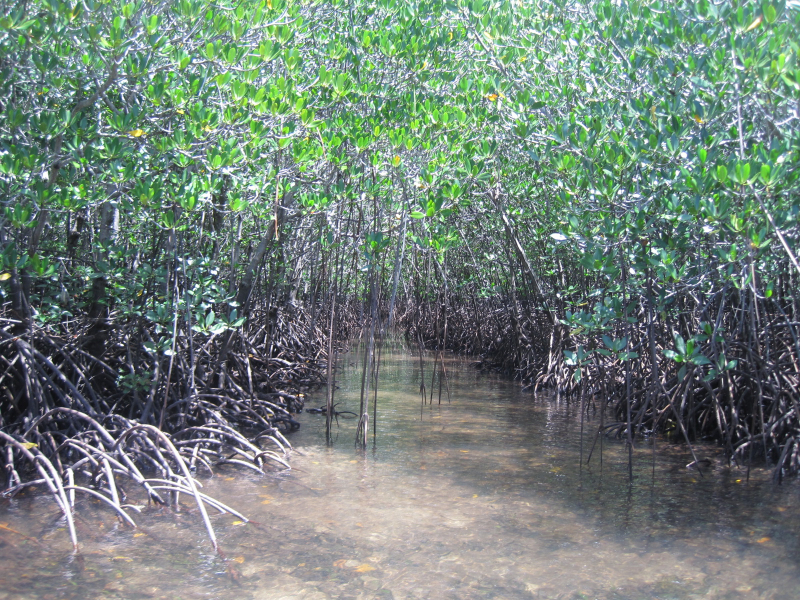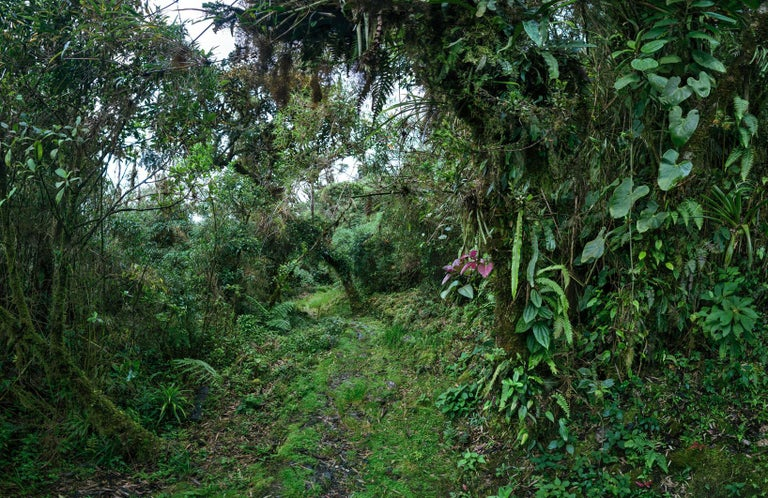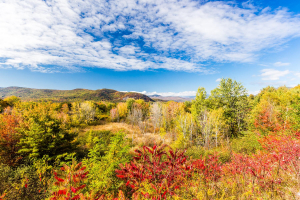Top 10 Most Beautiful Forests in the Philippines
With its beautiful islands, idyllic beaches, sunny climate, and incredibly rich scenery, the Philippines is rapidly emerging as a tourist destination rivaling ... read more...Thailand and Indonesia. Let's discover the most beautiful forest in the Philippines with Toplist - an interesting destination for tourists.
-
Sayang Mossy Forest (also known as "upper montane forest" or "cloud forest") is distinguished by short trees with gnarled trunks and branches that reach 8 meters in protected areas but only 2-3 meters on ridgetops. Most tree trunks and branches are covered in moss, which often hangs in sheets, and most ground surfaces are covered in moss and leaf litter over a thick layer of humus. Some mossy forests have podocarp conifers with low height but large girth (up to 2 m dbh); oaks, laurels, myrtles, and other trees are common, and rhododendrons are common shrubs. Ants and termites are not present, but earthworms abound. The majority of trees have 2-4 cm leaves.
Sayang, also known as the Deers' Playground, is a valley of pristine mossy forests. In some areas, the trees are so stunted that deer or wild pigs can be seen running around. It is a biological paradise, but no documentation has been done up to this point. As a result, no one knows the extent of its biological diversity. Sayang Mossy Forest is home to numerous brooks and rivers that provide irrigation and household water to the surrounding communities. It's an eerie yet wonderful feeling to have discovered this hidden paradise.
Location: Brgy Lias Kanluran, Barlig, Mt Province
via: Daniel's Eco-Travels 
via: Daniel's Eco-Travels -
Mt Amuyao is one of the tallest mountains in the Philippines. It is also one of the most preserved. Pine forests cover most of its lower elevations while mossy forests dominate the upper landscape. The upper elevations of Mt Amuyao also host rare dwarf bamboo as well as different species of flowering shrubs. During summer, you can witness these in full bloom.
At the summit, a display of wild flora will greet you: there are pink flowers, highland grass, wild orchids, and other rarities. The scenery is breathtaking, encompassing the high mountains of the Cordilleras to the west, and the Sierra Madre to the east. Its biodiversity has earned the notice of scientists. Salcedo and Calora of the Benguet State University (2006) report that “A total of 280 vascular plant species belonging to 180 genera and 84 families were recorded from actual floristic surveys and vegetation analysis of the northern slope of Mt. Amuyao”.
Location: Brgy Macalana, Barlig, Mt Province

via: Daniel's Eco-Travels 
via: Daniel's Eco-Travels -
Mt. Pulag National Park lies on the north and south spine of the Grand Cordillera Central that stretches from Pasaleng, Ilocos Norte to the Cordillera Provinces. The summit of Mt. Pulag is covered with grass and dwarf bamboo plants. At lower elevations, the mountainside has a mossy forest veiled with fog, and full of ferns, lichens and moss. Below this is the pine forest growing on barren, rocky slopes. Falls, rivers and small lakes mark the area.
Mt Pulag National Park is one of the Philippines' few protected forests. It is also a popular hiking destination in the country. Despite their protected status, many of the lower elevation forests have been converted into commercial farms. The majority of Mt Pulag's upper elevations are covered in mossy forests. The Park's flora and fauna are diverse, with many species being endemic to the mountain. Threatened mammals include the Philippine Brown Deer, the Northern Luzon Giant Cloud Rat, and the Luzon Pygmy Fruit Bat. There are also several orchid species, some of which may be endemic to Mt. Pulag, as well as other rare flora such as the pitcher plant.
Location: Kabayan, Benguet
via: Wikipedia 
via: PuertoParrot.com -
The mystical mountain of Mt. Arayat lies within the municipalities of Arayat and Magalang in Pampanga and is considered one of the most accessible parks in Manila. The Pampanga River, the second largest in Luzon, runs through the provinces of Bulacan, Pampanga, and Nueva Ecija. Mt. Arayat, known for its clear water cascading from its waterfalls and for its refreshing surroundings, was designated as a Forest Reserve in 1921 and then as a National Park in 1933.
Mt. Arayat is home to endemic and endangered flora and fauna, as well as geological rock formations with ecotourism potential. It also serves as an important source of water for Arayat and Magalang residents' domestic and agricultural needs. There are 23 creeks in the area that serve to irrigate an estimated 350,000 hectares of rice fields surrounding Mt. Arayat National Park. Despite years of encroachment, many of Mt Arayat's forests remain intact. As a result, while hiking to the summit, you may encounter monkeys and deer. Civet cats, wild pigs, and native birds thrive as well.
Location: Arayat, Pampanga
via: BusinessMirror 
via: Our World in Words -
The Sierra Madre is the country's longest mountain range. It also has the Philippines' largest tract of primary forest. It reaches all the way from the southern provinces to the northern tip of mainland Luzon. The Northern Sierra Madre Natural Park, a section of the range, is on UNESCO's tentative list of World Heritage Sites. It is home to a diverse range of endemic flora and fauna. Various indigenous groups live in various parts of the Sierra Madre. They have lived in harmony with their natural environment for centuries.
The park is regarded as the richest in the Philippines in terms of genetics, species, and habitat diversity. It is regarded as one of the most important protected area systems in the Philippines due to the abundance of rare and endangered flora and fauna that it protects. The Philippine eagle, the giant golden-crowned flying fox, the Philippine eagle-owl, the Isabela oriole, the green sea turtle, the loggerhead sea turtle, the hawksbill sea turtle, the Philippine crocodile, and the dugong are among them. It also serves as a breeding ground for the green-faced parrotfinch and the Northern Sierra Madre forest monitor. The park is also home to many endemic plant species. It straddles two ecoregions. The Luzon rain forests extend from sea level up to 1000 meters elevation and are characterized by various species of tall, straight, and slender trees of the family Dipterocarpaceae. The Luzon montane rain forests include areas above 1000 meters elevation, and the predominant trees are oaks and laurels. The park is home to various orchids such as Dendrobium aclinia, the leguminous plant millettia, and species of citrus (Aurantioideae).
Location: 833P+2FV, Ilagan, Isabela

via: Wikipedia 
via: Wikipedia -
The Samar Island Natural Park in Samar is the Philippines' largest contiguous tract of old-growth forest. With an area of 333,300 hectares, it is the country's largest terrestrial protected area (824,000 acres). The buffer spans the island's three provinces (Eastern Samar, Northern Samar, and Samar Province) and covers 458,700 hectares (1,133,000 acres), or roughly one-third of the island of Samar. It is a biodiversity and endemism hotspot in the Philippines, home to a number of threatened species from the Eastern Visayas and Mindanao biogeographic regions.
The natural park consists of an interior highland with distinct accordant peaks and limestone or karst terrain surrounding it. The landscape in the south is made up of jungle-covered limestone ridges. Its geology is predominantly Miocene and Holocene, with a sedimentary formation made up of basement rocks and overlying clastic rocks or limestone. Grasslands, agroforestry areas, forest-over-limestone, riparian ecosystems, lowland mixed dipterocarp forests, and mossy or cloud forests are among its ecosystems. The Philippine eagle has been observed in the forest. It is also home to a large number of Philippine eagle owls, Philippine tarsiers, Philippine flying lemurs, and Philippine tree squirrels.
Location: 26P6+QVC, Maslog, Eastern Samar, Philippines
via: Tripadvisor 
via: VisMin.ph -
Mount Dulang-dulang, also known as Mount Katanglad by Filipino mountaineers, is the highest elevation peak in the Kitanglad Mountain Range, which is located in the north-central portion of the province of Bukidnon on the island of Mindanao. Mt. Dulang-pristine Dulang's mystical environment qualifies it as one of the Philippines' three highest mountains, alongside Mt. Apo and Mt. Pulag.
The jungle on Mount Dulang-dulang will become so dense that it will cover almost everything. Trees resemble bonsai, with spiraling, convoluted branches and lichen and white moss 'beards' that give the forest an 'ancient' feel. Even during the day, the temperature drops, and when you emerge from the jungle to the clearing at the peak, you can see the entire Kitanglad range and even catch a glimpse of the majestic Mt. Apo.
Location: Bukidnon, Mindanao, Philipines
via: SarWrites 
via: Rice and Fries -
Balbalasang–Balbalan National Park (also known as Mount Balbalasang National Park) is a Philippine protected area in the municipality of Balbalan, Kalinga, in the Cordillera Administrative Region. The park is 1,338 hectares in size and is centered on Mount Balbalasang in the same-named barangay near the provincial border with Abra. The park dubbed the "green heart of the Cordillera", represents the region's rich biodiversity and landscape, with some of the most intact pine forests and endemic flora and fauna.
The park, an important center for biodiversity conservation, is home to 89 bird species, 39 of which are endemic to the Philippines and two of which are only found in Luzon, the Isabela oriole (Oriolus isabellae) and flame-breasted fruit dove (Ptilinopus marchei). While no recorded species are critical or endangered in the park, four bird species are vulnerable (2002 IUCN Red List of Threatened Species), including the whiskered pitta (Pitta Kochi), Luzon water-redstart (Ryacornis bicolor), and Luzon jungle flycatcher (Rhinomyas insignis). In addition, 23 mammal species, 13 amphibian species, 13 reptile species, and 25 earthworm species have been documented. Among them are the Philippine warty pig, Luzon striped rat, Northern Luzon giant cloud rat, Kalinga narrow-mouth toad, and Luzon narrow-mouthed frog. Two of these mammal species are listed as endangered, namely the Luzon pygmy fruit bat and the Luzon bushy-tailed cloud rat. At elevations above 1,000 m., the park consists of hardwood, pine, and mossy forests. A species of Rafflesia flower has also been discovered in the park.
Location: 92P6+C6P, Pasil, Kalinga, Philippines
via: Visit Philippines by Travelindex 
via: LeisureCrew Activities and hobbies -
The Banacon Island Mangrove Forest is now an eco-tourist destination with an approximate area of 425 hectares of Mangrove Forest established through a community effort that started last 1957. The Municipality of Getafe, located north of Bohol province, is now considered the biggest mangrove plantation in the country.
This extensive mangrove plantation also has established scenic trails beneath overlapping and intertwining mature mangrove trees that are breathless to behold. The trees are a monoculture of the “bakauan” (Rhizophora Stylosa), the most common mangrove species found in the river systems, estuaries, and off-shore islands of the Bohol province. Rhizophora Stylosa is a genus of tropical trees that generally lives in inter-tidal areas which are inundated daily by the tides. All the Rhizophora species have arching stilt roots that emerge from the trunk. The tangled and intricate root systems of the bakauans provide shelter to hundreds of fish species that are native to the waters around Banacon Island. They also serve as critical spawning grounds or nurseries for the fishes, seahorses, shrimps, crabs and other marine life.
Location: Getafe, Bohol, Philippines
via: whateverbyroxipie - WordPress.com 
via: Bohol Philippines Travel Guide -
The Luzon Montane Rainforests include the high elevations of numerous mountain ranges, including the Northern and Southern Sierra Madre, which run parallel to Luzon's northeastern coast. The island of Luzon is located in the western Pacific Ocean. It is the Philippines' largest island and is located at the northern end of the island group. The montane forests are extremely valuable due to the abundance of endemic species. They prevent soil erosion and protect water quality.
This forest is one of the Philippines' organically least well-known ecoregions. As a result of its long isolation from other landmasses, Luzon has produced many exceptional species of plants and animals. This ecoregion's montane forests begin at about 1,000 m and are distinguished by the presence of oak and laurel species. Because of the thick moss covering the branch, tree branches appear many times thicker than they are. Because of the thick moisture and abundant organic material on and around trees in this area, plants that are not typically epiphytes become aerial.
Location: Luzon Island, Philippines
via: Wikipedia 
via: 1stDibs































